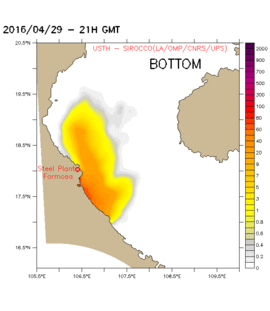
From April 6 to April 20, 2016, millions of fish and dead shells were found on 200 kilometers of coast of central Vietnam (Ha Tinh, Quang Binh, Quang Tri and Thua Thien-Hue). A huge steel complex is believed to be responsible for the pollution. The sea was contaminated with toxic effluents discharged by a pipe located 1.5 km from the coast and 17 meters deep.
The SIROCCO group associated with the laboratory HILO conducted numerical simulations to simulate the dispersion of a tracer issued at the point of driving. For this, a realistic hydrodynamic simulation was first carried out. It uses a curvilinear grid whose resolution is maximum (1.5 km) along the coast of Vietnam. This model is initialized and forced to its limits open field first global model provided by MERCATOR-OCEAN (Copernicus program), it is forced by the tide (FES2012 atlas) and the surface by three-time fields produced by the European Center Meteorological Weather Forecast for Medium term forecast (ECMWF) and climatological river flows. The model was initialized in January 2015 and turned up in late April 2016. Since the beginning of April, the current fields were stored every 3 hours to perform simulations of dispersion of a tracer. The tracer was released between 4 and April 8. A quantity of 20 g / s was introduced at the bottom corresponding to a discharge of 45,000 m3 / day, maximum discharge of conduct and arbitrary tracer concentration of 40 g / m3.
The figure shows against the tracer concentration in the base layer (g / m3). The simulated slick stretches after a month of about 130 km of coastline south of the discharge point. This range is comparable although weaker than that on which the dead fish were found. The sensitivity of this result to different forcing terms could be tested (wind resolution, river flow …). An animation shows the dispersion during the month of April. The high frequency movements are the result of alternative tidal currents. The off simulated contamination could correspond to a fish kill not limited to fish living close to the surface but also in fish living in deep and distant from the coast.
